Index


Review: Low-profile GTX 750 card
The Nvidia Geforce GTX 750/750 Ti launched in February as low to mid-range Geforce 700 series graphics cards, but what makes the new cards interesting is the fact that they are company's first Maxwell based products. Both cards feature a relatively low price and very low power consumption, yet they promise fairly good performance. Today, we’ll introduce you to KFA2’s GTX 750 OC. While some Nvidia AIB partners used the "bigger is better" approach with their custom GTX 750/750Ti cards by adding massive coolers and additional power connectors, KFA2 decided to roll out a low profile GTX 750 card, which is good news for HTPC. However we believe that many HTPC users will not like the fact that the card is dual slot, but then again there is no other low-profile single slot GTX 750 card on the market.
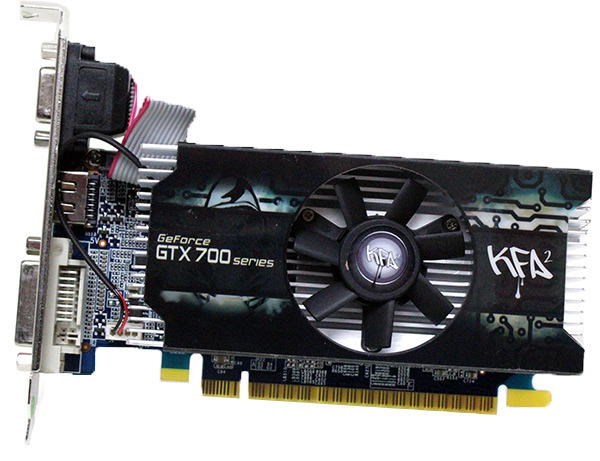
The GTX 750 features a GM107 GPU, which is based on the all new Maxwell architecture. A very similar product based on the same GM107 GPU is the GTX 750 with the Ti suffix. Subsequent Maxwell models should move down to the 20nm manufacturing process, but the GM107 is made on the good old 28nm node. Nvidia’s Maxwell architecture delivers exceptional performance per watt, made possible by redesigning and optimizing the old Kepler architecture.
The results are impressive. The GTX 750 and GTX 750 Ti use about half as much power as old GTS 450 and GTX 550 Ti cards, hence they can even deliver smooth 1080p gaming without external power. The PCIe slot delivers enough juice. The GTX 750 Ti is said to have a 60W TDP and the GTX 750 has a 55W TDP. The cards do not even use the full potential offered by the PCIe slot (75W). This is another factor that bodes well for HTPC/SFF builds, as there is less heat to deal with and you don’t need a huge PSU to get decent performance.
The GM107 GPU in the GTX 750 card has 512 shaders, 16 ROPs, 32 TMUs and four streaming multiprocessors (SMs). The GTX 750 Ti is more powerful and it features 640 shaders, 16 ROPs, 40 TMUs and five streaming multiprocessors.
The reference GTX 750 Ti is equipped with 2GB of memory, while the reference GTX 750 comes with 1GB of memory. In both cases the memory uses a rather narrow 128-bit interface. The memory for the GTX 750 is clocked at an effective data rate of 5010MHz, while the Ti model is somewhat faster at 5400MHz. KFA2 and many other AIB partners also have GTX 750 cards with 2GB of memory.
KFA2's GTX 750 OC is just one of many cards with a non-reference cooler and there are other even higher factory overclocked models from other vendors as well. However only KFA2 uses a low profile PCB. We should also point out that you could see the GTX 750 OC card under a different brand, i.e. Galaxy, as KFA2 is Galaxy's brand for the EMEA region.
The reference card comes with a base GPU clock of 1020MHz (1085MHz Boost), while the KFA2 card comes with a Base clock of 1072MHz (1150MHz Boost). The reference memory bandwidth is 80.2 GB/s, and it is the same on the KFA2 card because the memory is not overclocked and it works at 5010MHz GDDR5.
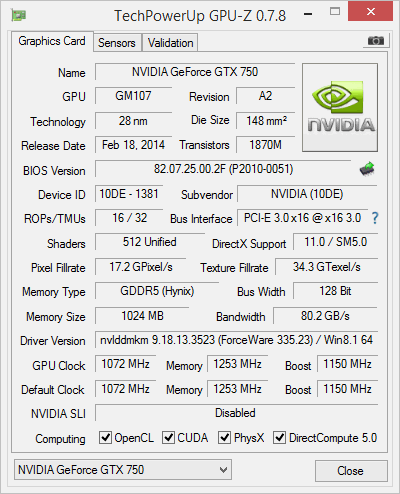
The box is pretty nice and it contains the essentials. You will only get the card, manual, driver and utility disc. The card is not advertised as low profile card and it does not ship with a low profile bracket. The card has standard HDMI, Dual-link DVI-D and VGA outputs.
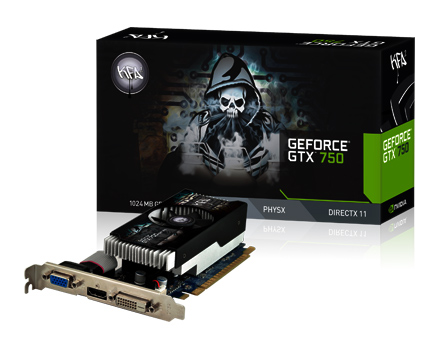
Here is a closer look at GTX 750 OC:

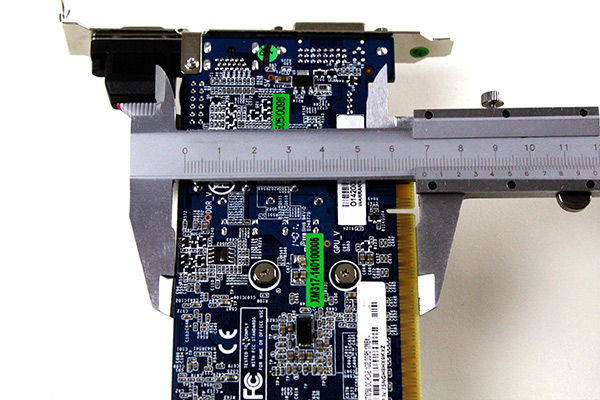
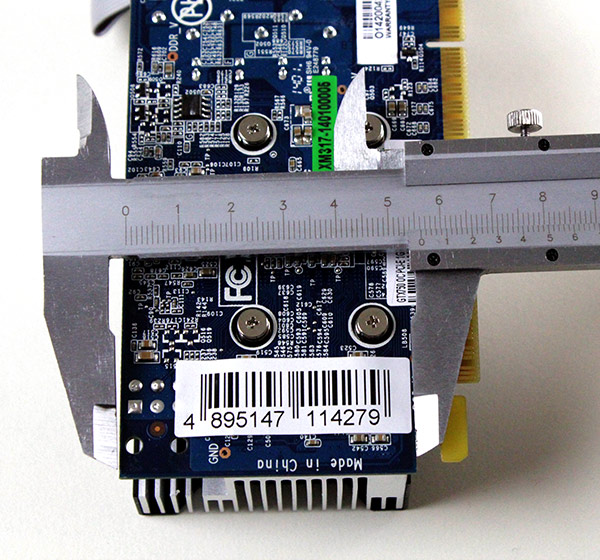
The cooler is a dual-slot solution with an oversized heatsink and a very small fan. Small fans usually result in plenty of high pitched noise, but that is not always the case. The fan is actually surprisingly quiet in 3D mode and in idle it is practically inaudible.
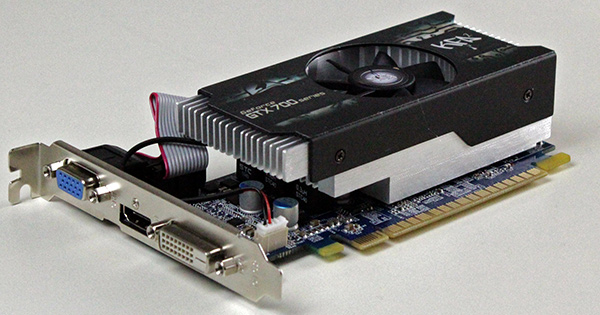
You can use all three video outputs at the same time; dual-link DVI, HDMI and VGA. The next image shows a size comparison with the XFX R7 240 Core Edition LP card.
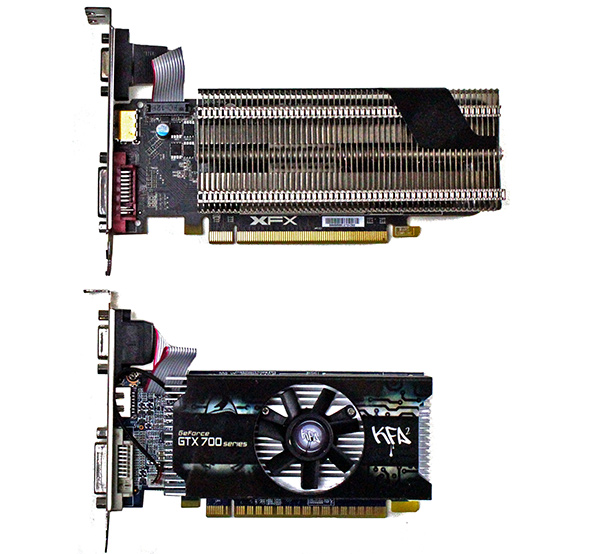
The next image shows a size comparison with the EVFA GTX 750 Ti ACX card.
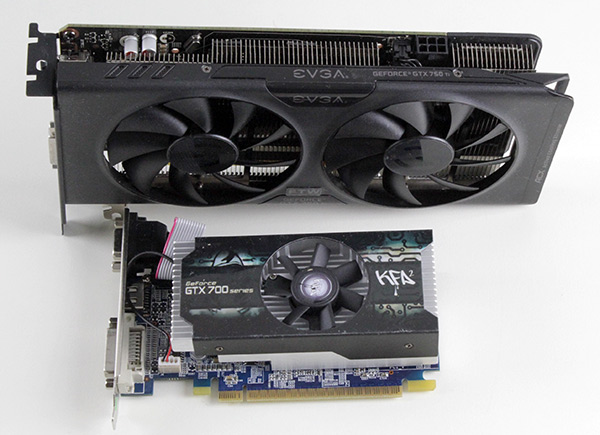
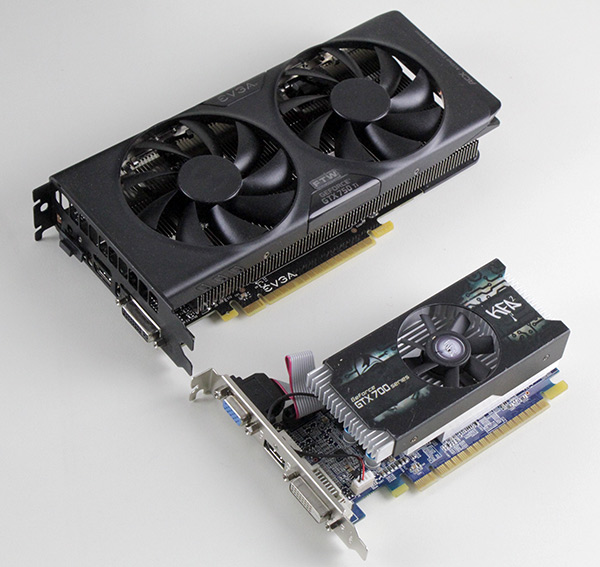
As we said, the card does not require an additional power connector.
Testbed:
- Motherboard: Intel DZ87KLT-75K
- CPU: Intel Core i7 4770K, 4x3.5GHz (Haswell)
- CPU Cooler: EVGA
- Memory: 2x4GB Corsair DDR3 2400MHz
- Harddisk: Corsair Neutron GTX 240GB
- Case: CoolerMaster Cosmos II
- Operating System: Win8.1 64-bit
- Motherboard: EVGA Z-87 Stinger
- CPU: Intel Core i7 4770K, 4x3.5GHz (Haswell)
- Memory: 2x4GB Corsair DDR3 2400MHz
- Harddisk: Corsair Neutron GTX 240GB
- Case: EVGA Hadron Air
- CPU Cooler: EVGA
- Operating System: Win8.1 64-bit
Drivers:
- Nvidia GeForce 335.23 WHQL drivers
- AMD Catalyst 14.2 V1.3 Beta for Windows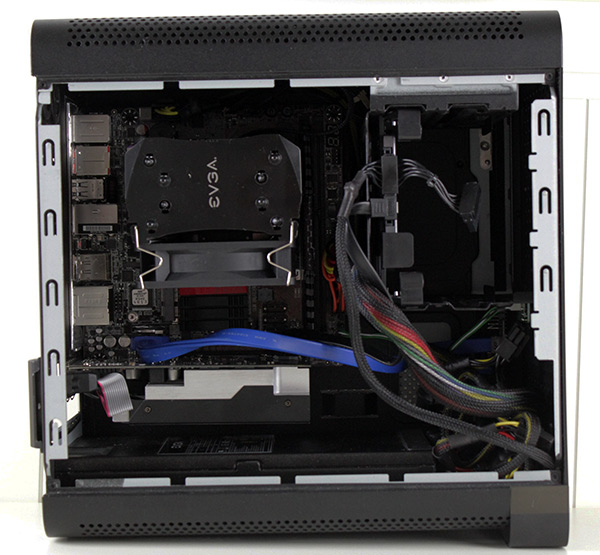
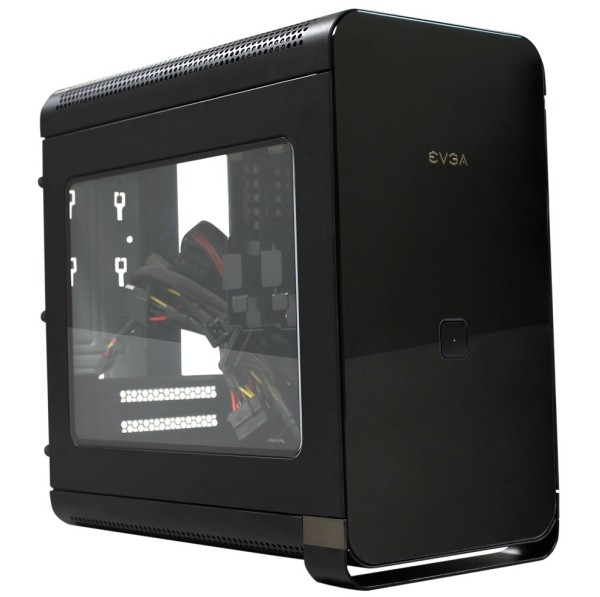
Today’s AAA games offer an impressive glimpse into a virtual world comprised of hundreds of thousands of polygons, high resolution textures and a lot of special effects. The visuals are stunning, provided you have a graphics card that can handle the load.
Nowadays high-end GPUs ship with at least 3GB of GDDR5 memory, but on the other side of the spectrum you can still find plenty of entry-level and lower mid-range cards with just 1GB of memory. KFA2’s GTX 750 is one of them, it features just 1GB of GDDR5. However, it is still a surprisingly potent card, especially when you factor in the ~€100 price tag. It can handle most games on medium/high detail settings, at 1080p. Even the most demanding games available today can be enjoyed at 1080p, but the detail levels need to be dialled down a notch.
Many partners offer 2GB versions in this market segment, but to be honest in most cases you won’t be able to tell the difference. To make good use of more memory you also need a faster GPU.
During our Battlefield 4 test at 1080p, with high in-game settings, we noticed that the memory is almost constantly filled to capacity. 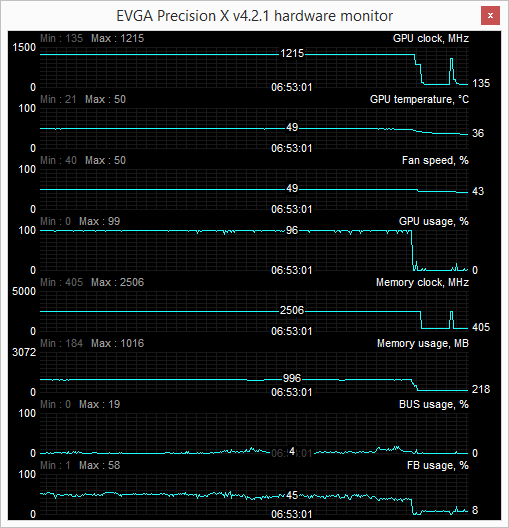
However, when we reduced the level of detail using GPU Experience optimal settings for 1080p, the game used up to 900MB of memory. 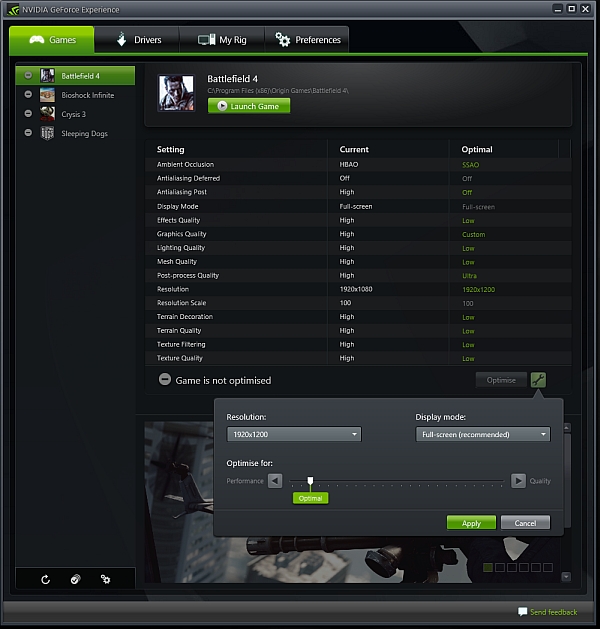
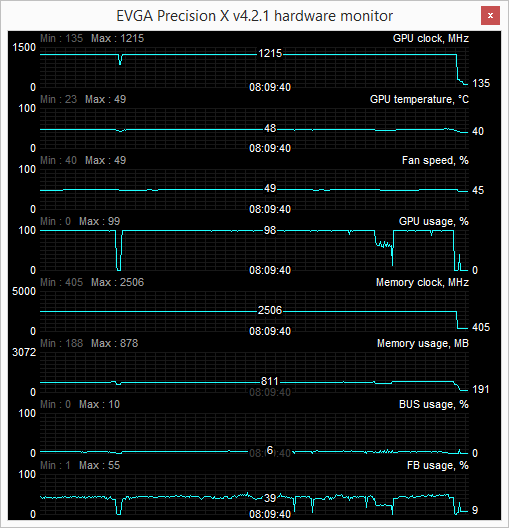
The good news is that you can enjoy Battlefield 4 with optimised settings. Even at high in-game settings we managed to get about 37fps. The GTX 750 cannot cope with ultra in-game settings, but with a bit of optimisation it should deliver playable frame rates at 1080p.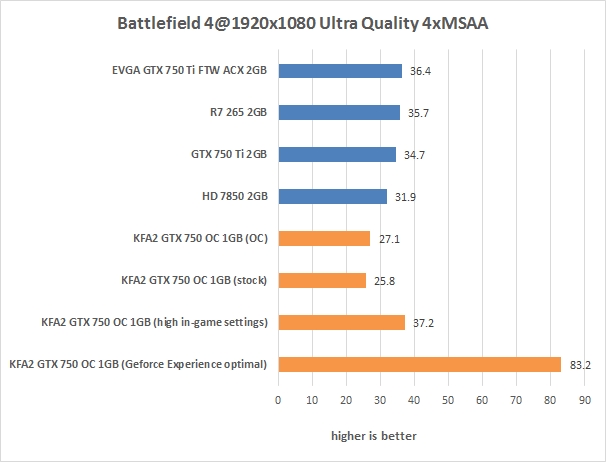
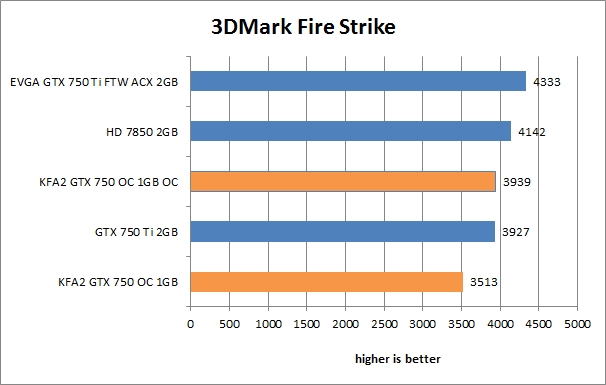
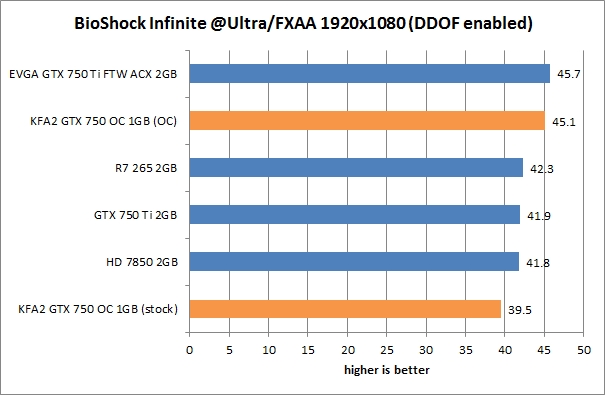
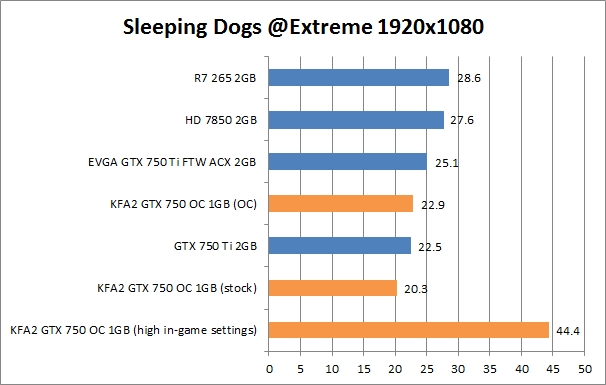
While idling the GPU temperature ranged from 32 to 34 degrees Celsius. The card is silent in idle. Although the cooler is relatively simple, with no copper base or heatpipes, the temperatures during our gaming tests were rather low. The cooler can keep the GPU temperature under 56 degrees Celsius at all times.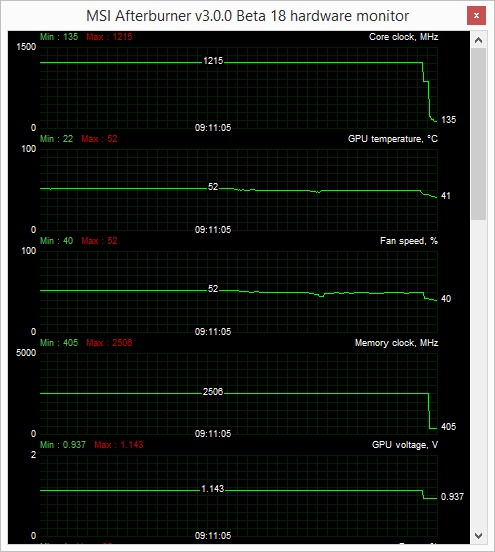
To test the limits of its cooler we placed the KFA2 GTX 750 OC into a compact EVGA HadronAir chassis. When you see a low-profile card in a mITX chassis, it tends to look rather big, but looks can be deceiving. It’s a tiny card in a compact chassis. Thanks to its low profile design it can fit into most small form factor chassis. However, bear in mind that it’s a dual-slot card, which may be a problem for some mITX enclosures.

As you can see from the graph below, thanks to the relatively low TDP of the GM107 (55W), the whole system draws well below 200W.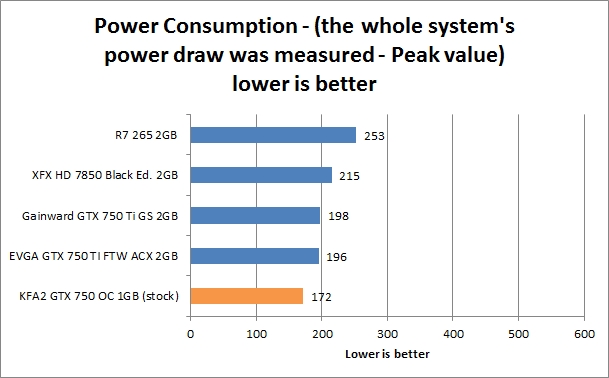
The KFA2 GTX 750 Ti OC card comes with a moderate factory overclock which sets the GPU base clock at 1072MHz, while the reference GPU base clock is set at 1020MHz. Nvidia's GPU Boost 2.0 takes the average GPU clock to 1085MHz for the reference GPU and to 1150MHz for the KFA2 card. The ‘Power Target’ slider is set at 100% by default and there is no way to increase the power target beyond that. But the ‘GPU Clock Offset’ slider can be adjusted, so we tried it and using the standard voltage and AUTO fan settings we managed to push the GPU 150MHz over the factory clocks. Thanks to Nvidia Boost 2.0 we were running at 1365MHz on the core. We ended up with a memory clock of 6212MHz. We were able to get another 10% performance out of this graphics card. The overclock can vary from game to game, as not all games place the same amount of load on the GPU.
The overclocking potential is good considering that overclocking is constrained by Nvidia’s power limiter. Note that the GTX 750 card has 55W TDP and it does not come with an external power connector. If you push it too hard the card will reduce the base GPU when it gets close to the PCI power limit. Still, it has plenty of overclocking potential, as the PCI slot can cope with 75W, or 20W more than the reference card needs.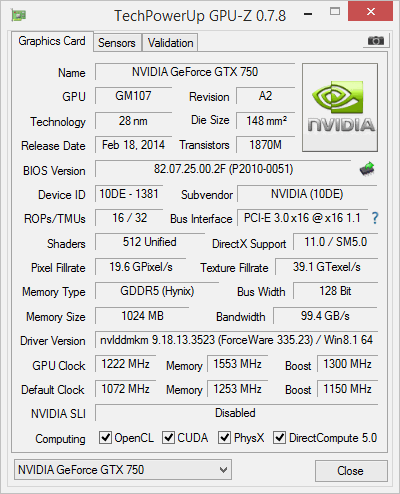
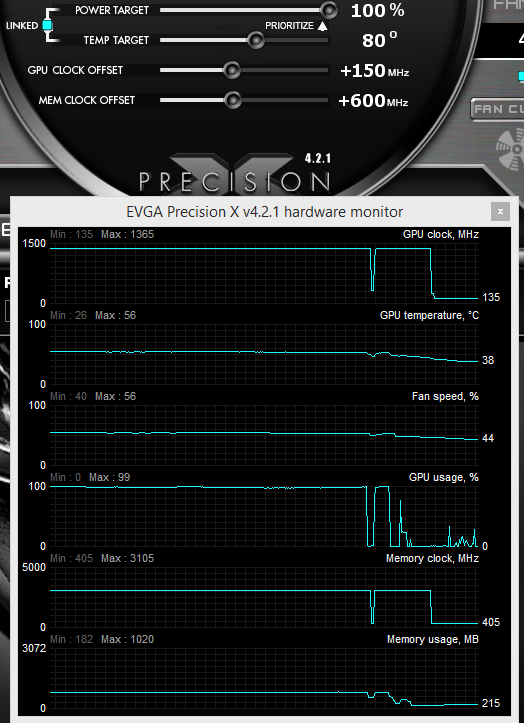
You can use XtremeTuner+ for overclocking and monitoring.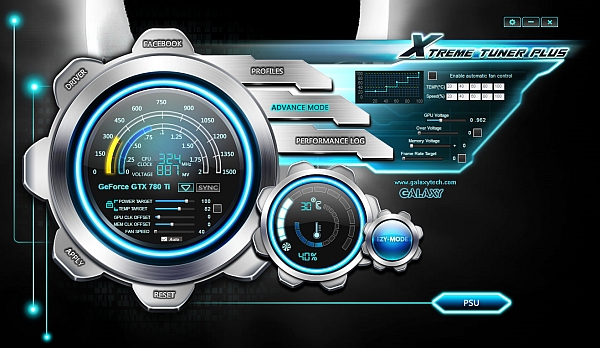
Considering the fact that the KFA2 GTX 750 OC is a low profile card, it must be said that it is one of the best products in this niche. It is definitely one of the fastest, if not the fastest card you can fit into a small form factor chassis limited to low profile cards. With that in mind it’s hard not to recommend KFA’s low-profile GTX 750.
The card can deliver playable frame rates at 1080p, provided you don’t go too far with the level of detail. That means it is practically the only low-profile card capable of handling the latest titles. However, if you really want to enjoy more eye candy at 1080p, you’re probably better off with a GTX 760 or Radeon R7 265.
We were somewhat concerned that the tiny fan would end up too loud, but luckily we were wrong. It is practically silent and it doesn’t get too loud when it’s pushed to its limits. Compact form factor aside, the card is relatively frugal, with a TDP of just 55W. Sadly, KFA2 did not include a dual-slot low profile bracket with the card.
For the time being the KFA2 GTX 750 OC is the only low-profile GTX 750 card on the market. It is priced at €109, making it one of the most expensive GTX 750 cards with 1GB of memory, but then again there’s simply nothing like it on the market, so if you’re building a SFF rig you’ll have to pay small premium.
KFA2’s GTX 750 is a very interesting card for everyone looking for a low-profile card with enough muscle to run the latest games. The card really opens up a lot of opportunities for SFF lovers and raises the bar for low-profile cards, hence it gets our recommendation hands down.

